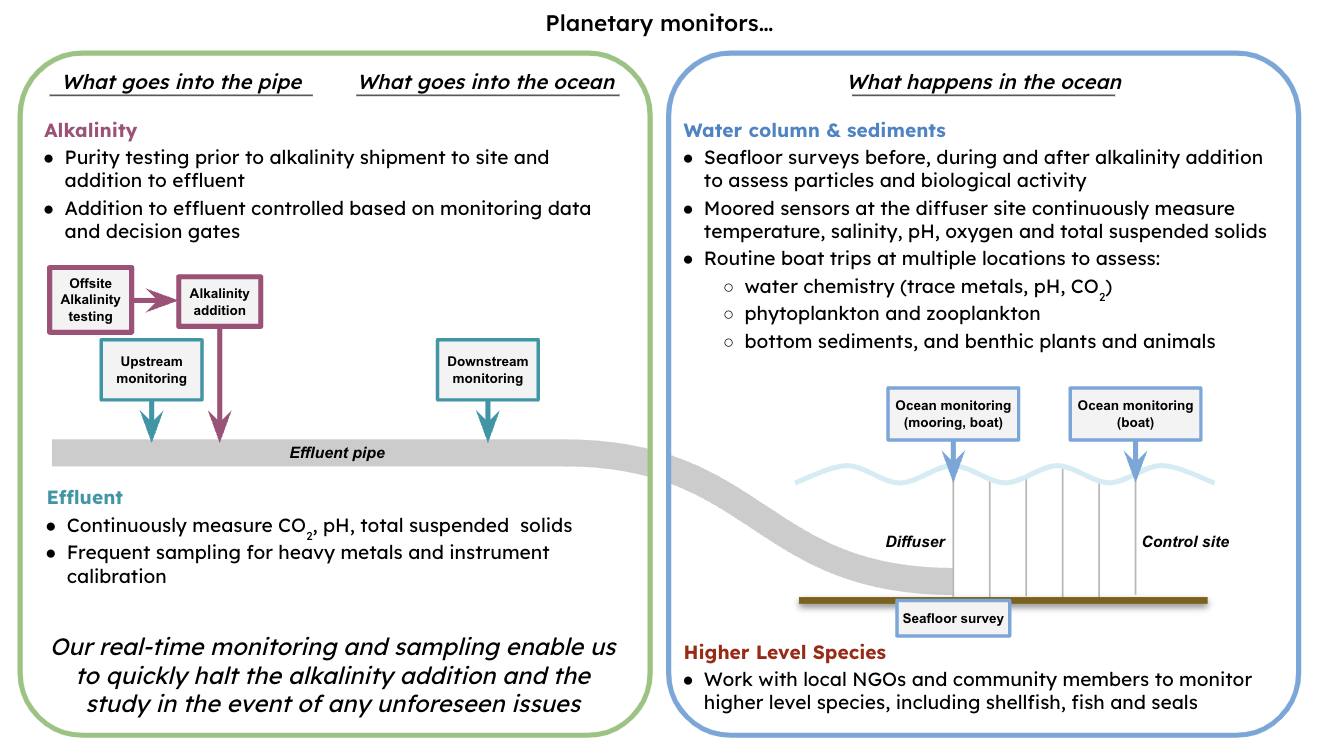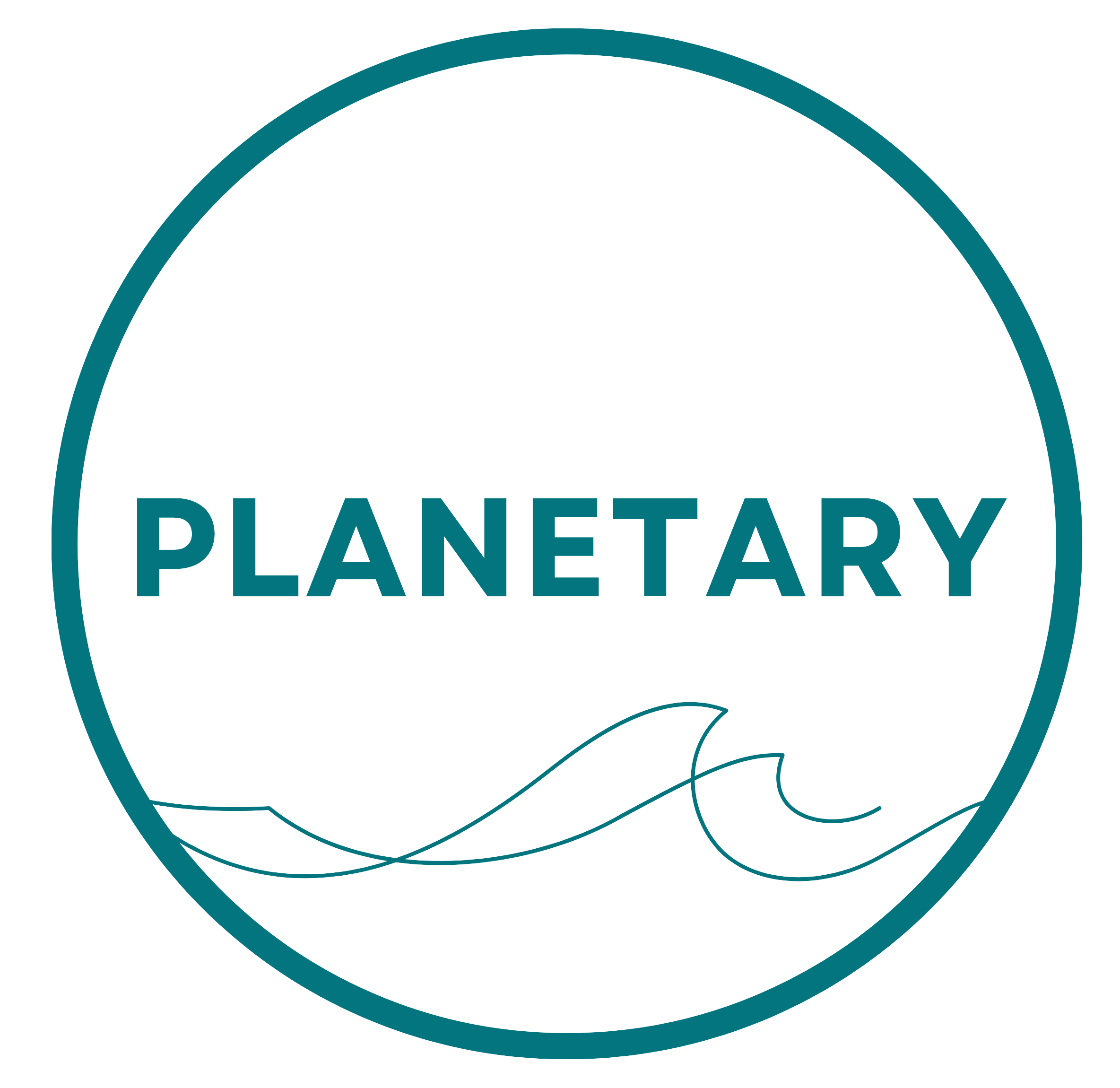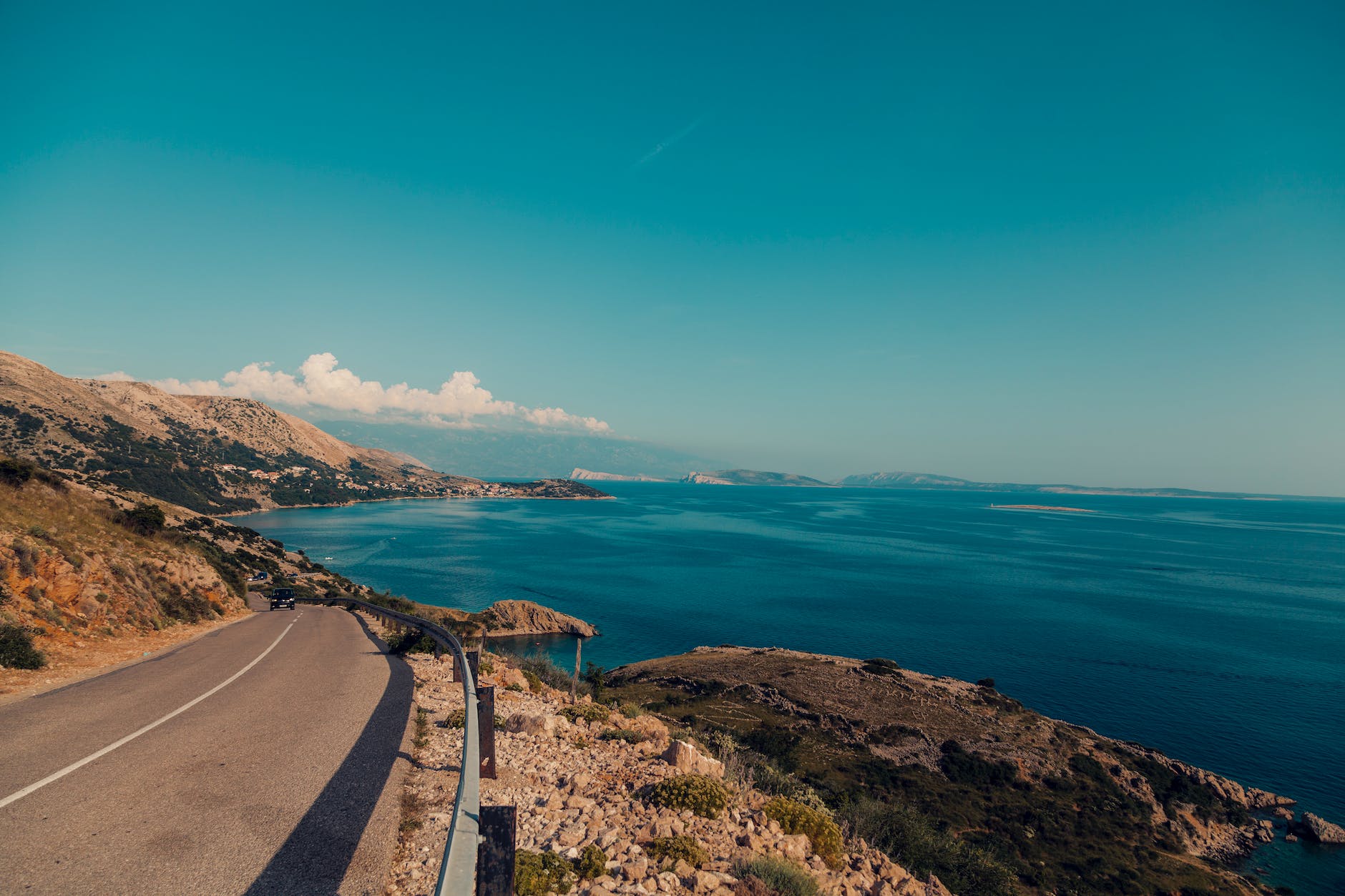We won’t conduct studies that we think are likely to cause harm. That simply would go against everything we believe in – our code of conduct, the scientific method, our dedication to restore the ocean.
Nonetheless, we still need to monitor and record our activities in the ocean – both to be sure that our assumptions are correct and nothing unexpected occurs, and to be able to document and transparently report on our carbon removal achievements. I’m going to use the design of our monitoring program at Hayle as an example of how we approach monitoring in general.
The Hayle and St Ives monitoring program
The monitoring program is designed to achieve three primary objectives:
- To ensure we remain compliant with permit requirements and environmental quality standards at all times,
- To regularly collect and share data that demonstrate no unforeseen impacts, and thus are used as ‘decision gates’ to inform continuation of the trial (more detail below), and
- To collect a broad, extensive, and publicly available dataset that will thoroughly improve collective understanding of the local ecosystem and any interactions with wastewater input, while also establishing a strong baseline for any potential future activities.
Additionally, we do gather data in our monitoring process that we will use in verifying carbon removals. However, since that is not the main objective of this study, we are clearly concentrating on validating the safety and regulatory compliance of the process.
The monitoring program itself can be broken down into 3 main steps: testing the dry alkaline material before it is added to the wastewater pipe, monitoring the wastewater, and monitoring the ocean. This final step includes extensive biological monitoring.
Monitor the material to ensure it meets requirements
We test the dry alkaline material (in other words, testing what goes into the effluent) before it is shipped to Cornwall.
The material is tested before it leaves the supply point. Planetary will ensure the material aligns with regulations, the safety specifications that Planetary has developed, and the material’s MSDS (material safety data sheet – a standard for safe handling instructions and protocols).
This will be an elemental analysis test for the purity of the magnesium hydroxide, and to determine how much, if any, impurities are in the material (we assess 15 different trace metals and verify the absence of asbestos). Any batch that includes trace metal content above the safety thresholds from the regulators or by our specifications will not be shipped to the UK.
Monitor in the effluent pipe
We monitor the water before and after we add the magnesium hydroxide slurry. In other words, we test the effluent itself, which will make its way to the ocean.
Wastewater monitoring in the pipe is done in two locations: immediately upstream of the addition point, so we can have a baseline of the water before any addition, and approximately 200m downstream at another access point. Two types of monitoring will occur.
- Continuous monitoring
We measure the wastewater by pumping it directly through sensors collecting data every minute. This enables us to measure CO2 to assess carbon removal, pH to assess acidity and validate that we are not exceeding any regulatory limits, and suspended solids to assess particle loads, and validate compliance with regulatory limits. This data will be recorded and made public on a regular basis, both during and following the study. - Discrete samples
We collect samples from the monitoring points and analyze them regularly (starting at 1-2x per week). This enables us to conduct testing that is not possible on a “real time” basis, including trace metals (measuring total concentrations of 15 metals). Note that even though we have tested the trace metals of the material before the addition, we test here again to know more precisely what is being transported to the ocean, and to better understand how impurities dilute and interact within the wastewater. We also test for dissolved carbon and total alkalinity; this allows us to calibrate the continuous data and better assess the carbon removal that is occurring.
Monitor the chemistry in the ocean
We monitor in the ocean at and around the outfall site, assessing any changes occurring in the ocean.
Ocean monitoring is done at multiple locations: directly at the wastewater diffuser (the ‘diffuser site’), at a location further away from the diffuser (this serves as the ‘control site’), and other locations between these two points. This monitoring includes:
- A suite of sensors moored at the diffuser site. These will continuously measure water temperature, salt content, acidity (pH), oxygen, and total suspended solids. These data will provide the clearest evidence of whether our highly diluted addition can be detected in the ocean, and if so, what that detection tells us. These measurements will also enable us to learn about how the wastewater itself interacts with the marine environment, and will be used to calibrate regional ocean models that enable better prediction of the marine system as a whole.
- Regular boat trips (approximately every two weeks) to each station will enable us to monitor the other sites (away from the diffuser). These include:
- Water samples for trace metals concentrations, acidity (pH), CO2, and total suspended solids. These measurements help us determine any change from the addition, including carbon removal and any particle concentration that might be outside our expectations.
- Water samples for phytoplankton community composition and zooplankton.
- Visual inspection of the seafloor so we can immediately stop any addition if an accumulation is identified.
Monitoring using dive teams
Additionally, 3 intensive seafloor surveys will be conducted (before, during, and after study) using a dive team. The team will establish one survey location near the outfall, two sites sequentially further in distance from the pipeline outfall, and one control site in the adjacent bay east of Navex Point. Outcomes of the monitoring will include baseline establishment, and continued temporal analysis of:
- Species Richness
- Species richness is represented by the number of species per unit area.
- A greater number of species within the marine ecosystem indicates a more stable ecosystem.
- Species richness contributes to an increase in biodiversity, which is an important aspect of biodiversity conservation and determination of the health of an ecosystem.
- Species Evenness
- Species evenness refers to how close in numbers each species in an environment is.
- Mathematically it is defined as a diversity index, a measure of biodiversity which quantifies how equal the community is numerically.
- Species Diversity
- Species diversity is the number of different species that are represented in a community.
- Greater biodiversity in ecosystems, species, and individuals leads to greater stability.
- Species diversity is the number of different species that are represented in a community.
In conjunction with the biological analysis of the seafloor, additional sampling will be undertaken in the form of sediment cores
- Analysis and monitoring of sediment to determine environmentally significant levels of metals and other substances.
- Chemical characterization to understand the natural and anthropogenic influence on the ocean and benthic environment.

Summary of basic monitoring
Increasing the chance of finding any issues
Our study is quite short to minimise any chance of unforeseen change. Additionally, when considering dilution the concentration of the addition is really quite small – approximately 1 part alkaline material to 5000 parts wastewater – and then diluted again by the ocean – wastewater is diluted by, on average, a factor of about 1000 within 50-100 meters of the diffuser.
This culminates in an overall dilution of our material of 5,000,000:1.
Importantly, magnesium hydroxide is designated as a compound that does not bioaccumulate (see Registration Dossier – Magnesium hydroxide – ECHA. Retrieved March 21, 2023, from https://echa.europa.eu/registration-dossier/-/registered-dossier/16073, especially the sections on “Environmental Fate and Pathways” and “Ecotoxicological Information). This means that concerns regarding ecosystem impacts should focus on impurities in the alkaline product, and why, in turn, we dedicate so much effort to measuring trace metals. Even if large quantities of water magnesium hydroxide are consumed, we do not expect any harmful effects on higher level species.
Based on the short trial duration and the extreme dilution of our alkaline material once in the ocean, our monitoring efforts focus on the water quality and the base of the marine ecosystem. This maximises the chance that we will find any unforeseen changes.
We monitor the important next higher level species: shellfish
Even so, out of an abundance of caution, we will extend biological sampling and observation to higher level species to identify any reason for pausing or stopping the study due to unanticipated changes.
In these higher level species will we concentrate on shellfish (especially crabs and lobsters). We have also invited scientists and members of local NGOs, such as Cornwall Wildlife Trust, the Cornwall Seal Group Research Trust, Cornwall Inland Fisheries (C-IFCA), and the Royal Society for the Protection of Birds (RSPB), to help devise additional tests that may be deemed necessary.
Continuing monitoring, even after the study
Further, we include multiple “decision gates” at regular intervals during the study, where we make an active decision whether to continue the study. At each of these “gates” we will review with the regulator the data that has been collected to ensure that it is safe to continue. We will publish the data and decision process and the decision itself at every decision gate.
The extent of post-study monitoring, and the areas of focus within that monitoring, will depend on two main factors:
- Any findings that point to specific areas of concern. This study would not be proposed if we believed any areas of concern will arise, but data analysis will be rigorous, done by third parties, and all data collected will be publicly available, so any findings that raise concern will increase the frequency and rigor of future monitoring.
- Whether there is continuing research with additional studies If this study is successful, a second study, built upon success in 2023, would undoubtedly bring additional scientific and public interest to St Ives Bay. This would lead to a significant increase in the frequency and rigor of future monitoring.
That said, Planetary commits to monitoring after the study. The frequency and nature of this follow-up monitoring will be informed by any changes observed during the study, but a minimum will be agreed with experts from university and research organisations (for example, NOC, Plymouth University, PML Applications, and Exeter University) before the study commences.
Get involved in monitoring higher level species
The following ideas are also being explored, and we urge anyone with insights into how to put these ideas into practice, and everyone who has other ideas to improve the safety and rigour of the study, to reach out:
- Tracking marine mammal movements, for example using animals already tagged for conservation purposes, to assess the length of time these creatures spend near the addition site, and whether this appears to change as a result of our activities.
- Working with existing and ongoing processes, such as the Cornwall Wildlife Trust’s tissue studies of mammals, to identify any unanticipated changes.
- Another potential integration is to work with all the local citizen scientists reporting on any animal sightings, marine activity, or anything else of note in the region near the diffusers.



